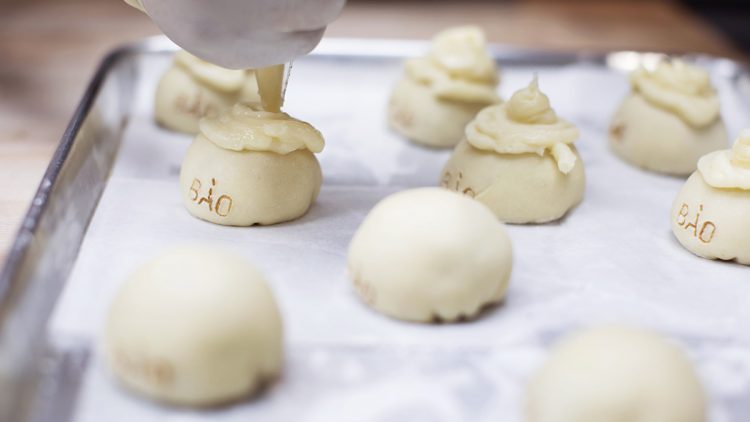Who doesn’t love a compact, hand-held meal? Especially when it involves a warm, soft bun stuffed with sweet or savory fillings? Enter: The bao.
These pocket-sized culinary delights originated in China more than 1,000 years ago with the classic steamed Mantou bun, and over the years have evolved into many different versions that can also be found in Taiwanese and Japanese cooking.
Baos (or baozi) are enjoyed as a snack, with lunch or perhaps dinner as an accompaniment to the main dish, and sometimes for breakfast, and take on different characteristics depending on where in the world you are enjoying them.
“My favorite bao bun is filled with ground pork and green onions, seasoned with pork rib broth, soy sauce, sesame oil, ginger, and five spice powder. This is probably the most popular type in mainland China,” says Fiona Mann, who grew up in a small town in the Anhui Province of East China and now lives in San Francisco. She has been making bao buns from scratch for decades with and for her family. “When I was a child in the 1980s, most of us could not afford to have pork buns for every breakfast. More often we had buns without any fillings.”
Filled, or unfilled, it’s hard to resist the fluffy dough snacks. And while we always jump at the opportunity to travel to experience new cuisines and culture, sometimes the heart wants what it wants, when and where it wants it – which may mean whipping up a batch of baozi while you binge watch the latest Netflix series in your living room in Des Moines. Here are our five tips for making the best bao at home – no passport needed.
Step 1: Find a great, classic recipe
We love the famous char siu bao, stuffed with sweet and sticky BBQ pork that can be found all over Hong Kong and are often seen at dim sum restaurants. This recipe from Mochi Mommy offers an easy-to-follow take on this classic recipe, adapted for the modern American kitchen (hint: there may be an Instant Pot involved).
Step 2: Fill ‘Em Up
Don’t feel limited to filling your buns with BBQ pork! We can’t think of too many fillings that wouldn’t be right at home in the middle of a fluffy bun. “In different areas of China, people make different kinds of bao buns,” says Mann. “Steamed, pan fried, and even roasted, big or small, all white or rainbow colored, meat or all veggies, salty or sweet like red bean buns, creamy custard buns, and more.”
For a delicious meat-free option, these Sweet Potato Steamed Buns from Full of Plants, packed with shredded sweet potato, mushrooms, and flavorful aromatics like lemongrass, shallots, and chili make for the perfectly portable vegan snack.
Step 3: Size (and Shape) Matters
While they may range in size from a small dumpling to a classic bun-shape, bao aren’t intended to be a fork-and-knife meal, so make sure you are getting the perfect dough-to-filling ratio to keep things under control. Chinese cuisine expert, co-other of The Noodle Cookbook, and in-house chef at Mr. Lee’s Pure Foods, Damien Lee, is originally from Macao and underscores the importance of size when it comes to ideal baozi. “A perfect bao bun shouldn’t be very big,” he says. “It should only require two or three bites to finish off.”
Step 4: Be Brave
Now that you’ve mastered some of the basics, like the dough, shaping, filling, and steaming, it’s time to explore the many different styles of bao, including baked, pan-fried, and the open taco-shell-style Taiwanese gua bao, stuffed with tender pork belly, cilantro, pickled mustard greens, and crushed peanuts. If you’re really brave, try your hand at xiaolongbao – AKA soup dumplings. Patience is also a virtue here too, so be careful you don’t learn the hard way how hot the inside of a soup dumpling can get by biting into it before it has cooled.
You should also give the traditional “pineapple bun” or bolo bao a try. These soft, slightly sweet pastries found in Hong-Kong-style bakeries don’t actually contain any pineapple. They get this name from the crust that is baked on top, which resembles the outside texture of – you guessed it – a pineapple. We tracked down the folks at the much-loved Bao Tea House in New York City, and sweet-talked them into giving us the recipe for their wildly popular take on this type of bao, which you can find here.
Step 5: Don’t forget the wine
Bao buns may not traditionally be served alongside a glass of wine, but we believe anything goes when it comes to filling your belly with delicious food and drink.
Just about everything pairs well with bubbly, so grab a glass of sparkling wine to sip with your bao. We love the juicy, barbera-based Pleasure Trip Pét-Nat sparkling wine from Tank Garage Winery for its strawberry and stone fruit notes, and deliciously creamy mouthfeel. Or, snag yourself a bottle of the newly permitted Prosecco Rosé, like Gancia’s pretty pink pour.
To play off some of the exotic flavors like ginger and lemongrass that we can often find in bao bun fillings, might we also suggest something zippy and aromatic, like Riesling or a funky white blend? In keeping with the theme, Charles Smith’s Kung Fu Girl Riesling from Washington State is always a treat, and was created with pairing with Asian cuisine in mind. For something totally unique (and delicious), try Matthiassaon’s Napa Valley White, an offbeat blend of sauvignon blanc, ribolla gialla, sémillon, and friulano.
If red wine is more your style, we recommend finding a selection that isn’t too tannic or high in alcohol, as sometimes these palate sensations can clash with the powerful flavors of Asian cuisine. We love the soft and easy-drinking Sangre de Toro Original, a blend of Garnacha and Cariñena from Catalunya, or Anarchist Wine Co.’s delightfully crushable Piquette to wash down whatever style of baozi you perfect.

